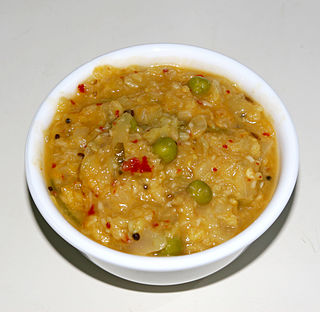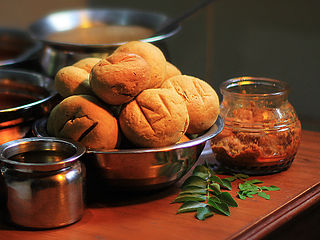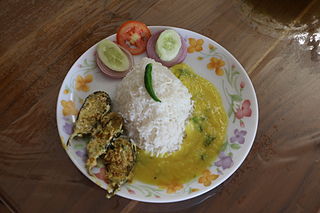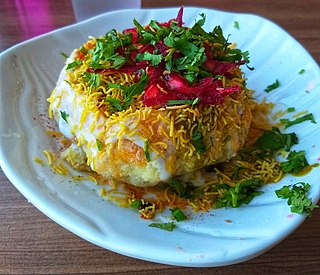Related Research Articles
Indian cuisine consists of a variety of regional and traditional cuisines native to the Indian subcontinent. Given the diversity in soil, climate, culture, ethnic groups, and occupations, these cuisines vary substantially and use locally available spices, herbs, vegetables, and fruits.

A dosa, dosai or dosha is a thin, savoury crepe in South Indian cuisine made from a fermented batter of ground black gram and rice. Dosas are served hot, often with chutney and sambar. Dosas are popular in South Asia as well as around the world.

Urad bean or black gram is a bean grown in South Asia. Like its relative, the mung bean, it has been reclassified from the Phaseolus to the Vigna genus. The product sold as black gram is usually the whole urad bean, whereas the split bean is called white lentil. It should not be confused with the much smaller true black lentil.

Punjabi cuisine is a culinary style originating in the Punjab, a region in the northern part of South Asia, which is now divided in an Indian part to the east and a Pakistani part to the west. This cuisine has a rich tradition of many distinct and local ways of cooking.

Pakora is a fritter originating from the Indian subcontinent. They are sold by street vendors and served in restaurants across South Asia. It often consists of vegetables such as potatoes and onions, which are coated in seasoned gram flour batter and deep fried.

Koottu (Tamil:கூட்டு), often transcribed "kootu", is a lentil and vegetable stew in South Indian, particularly Tamil and Kerala cuisines. The etymology for koottu derives from the Tamil word "koottu" which means "add" or "mixture/medley" i.e. vegetable added with lentils form the dish, which is semi-solid in consistency. The dish is noted for its nutty and complex flavors and textures, likely owing to the liberal addition of lentils and coconuts. It is typically less watery than sambhar, but more so than dry stir-fries. Virundhu Sappadu comes with a combination of boiled rice, sambar, rasam, curd, poriyal, koottu, appalam, pickles and banana. All koottus by default have some vegetables and lentils, but many variations of koottu exist:

Rajasthani cuisine is the traditional cuisine of the Rajasthan state in north-west India. It was influenced by various factors like the warlike lifestyles of its inhabitants, the availability of ingredients in an arid region and by Hindu temple traditions of sampradayas like Pushtimarg and Ramanandi. Food that could last for several days and could be eaten without heating was preferred.

Baati is a hard, unleavened bread cooked in most areas of Rajasthan, and in some parts of Madhya Pradesh and Gujarat states of India. It is prized for its long shelf life and high nutritional content, and, in desert areas, for the minimal quantity of water required for its preparation. Baati is commonly eaten with dal, hence also referred to as dal baati. In some regions, especially Madhya Pradesh, it is also paired with a roasted aubergine mash called bharta. Baati is also closely related to Litti (cuisine), popular in eastern Uttar Pradesh (Varanasi) and western Bihar. Litti is eaten with potato, tomato and roasted aubergine.

Dāl bhāt (Nepali: दाल भात, Hindi: दाल भात, Bengali: ডাল ভাত, Gujarati: દાળ ભાત, Marathi: डाळ भात, Assamese: দাইল ভাত dāil bhat / দালি ভাত dāli bhāt, is a traditional meal from the Indian subcontinent. It consists of steamed rice and a cooked lentil or other pulses stew called dal. It is a staple food in these countries. Bhāt or chāwal means "boiled rice" in a number of Indo-Aryan languages.

Indian breads are a wide variety of flatbreads and crêpes which are an integral part of Indian cuisine. Their variation reflects the diversity of Indian culture and food habits.

Kachori is a deep-fried, spicy, stuffed pastry originating from the Marwar region of Rajasthan, India. It is made of maida filled with a stuffing of baked mixture of moong dal or onions, besan, coriander, red chili powder, salt, and other Indian spices and deep-fried in vegetable oil until crispy golden brown. It is served hot with sweet and spicy tamarind chutney or occasionally with mint and green chilli chutney.
Bhojpuri cuisine is a style of food preparation common among the Bhojpuri people of Bihar, Jharkhand and eastern Uttar Pradesh in India, and also the Terai region of Nepal. Bhojpuri foods are mostly mild and tend to be less hot in terms of spices used. The cuisine consists of both vegetable and meat dishes.
Hyderabadi cuisine, also known as Deccani cuisine, is the cooking style characteristic of the city of Hyderabad and its surrounding area in Telangana, India.

Dhansak is a popular Indian dish, originating among the Parsi community. It combines elements of Persian and Gujarati cuisine. Dhansak is made by cooking mutton or goat meat with a mixture of lentils and vegetables. This is served with caramelised white rice, whole spices, and caramelized onions.
Bihari cuisine is eaten mainly in the eastern Indian state of Bihar, as well as in the places where people originating from the state of Bihar have settled: Jharkhand, Eastern Uttar Pradesh, Bangladesh, Nepal, Mauritius, South Africa, Fiji, some cities of Pakistan, Guyana, Trinidad and Tobago, Suriname, Jamaica, and the Caribbean. Bihari cuisine includes Angika cuisine, Bhojpuri cuisine, Maithil cuisine and Magahi cuisine. Dal Puri

Lahori cuisine refers to the food and cuisine of the city of Lahore in Punjab, Pakistan. It is a part of regional Punjabi cuisine. Lahore is a city with an extremely rich food culture. People from Lahore are famous all over the country for their love for food. The city offers a vast variety of options when it comes to gastronomy. In recent times, the style of food has achieved popularity in a number of different countries, because of its palatable and milder taste, mainly through the Pakistani diaspora.

Malaysian Indian cuisine, or the cooking of the ethnic Indian communities in Malaysia, consists of adaptations of authentic dishes from India, as well as original creations inspired by the diverse food culture of Malaysia. Because the vast majority of Malaysia's Indian community are of South Indian descent, and are mostly ethnic Tamils who are descendants of immigrants from a historical region which consists of the modern Indian state of Tamil Nadu and Sri Lanka's Northern Province, much of Malaysian Indian cuisine is predominantly South Indian inspired in character and taste. A typical Malaysian Indian dish is likely to be redolent with curry leaves, whole and powdered spice, and contains fresh coconut in various forms. Ghee is still widely used for cooking, although vegetable oils and refined palm oils are now commonplace in home kitchens. Before a meal it is customary to wash hands as cutlery is often not used while eating, with the exception of a serving spoon for each respective dish.

Daal dhokli is an Indian dish common in Rajasthani and Gujarati cuisine, made by boiling wheat flour pieces in a toor dal stew. A similar preparation is called varanfal, or chakolyaa in Marathi. It is commonly pronounced Dar Dhori in Gujurati. In some household traditions it is made out of leftover dal.

In Indian cuisine, dal, pappu, or paruppu are dried, split pulses that do not require soaking before cooking. India is the largest producer of pulses in the world. The term is also used for various soups prepared from these pulses. These pulses are among the most important staple foods in South Asian countries, and form an important part of the cuisines of the Indian subcontinent.

Medu vada is a South Indian breakfast snack made from Vigna mungo. It is usually made in a doughnut shape, with a crispy exterior and soft interior. A popular food item in South Indian cuisine it is generally eaten as a breakfast or a snack.
References
- ↑ "Try Rajasthani Pachmel Dal Made with 5 Dals for High-Protein Meal".
- ↑ "We Indians Love Our Dal. But do You Know the Fascinating History of Our Favourite Comfort Food?". 23 March 2017.
- ↑ "Panchratna Ri Dal - Times of India". The Times of India . Archived from the original on 27 September 2013. Retrieved 3 February 2022.



